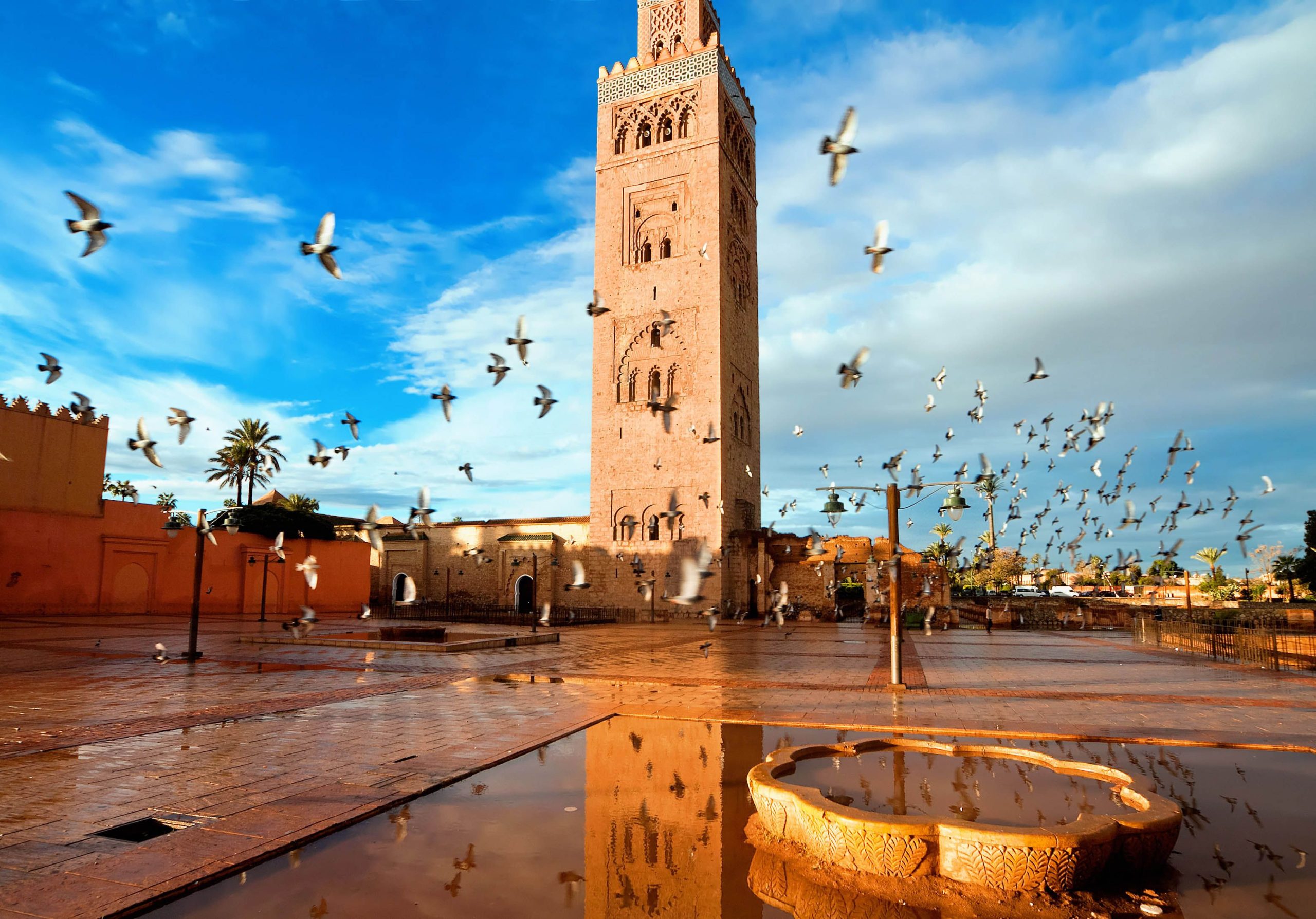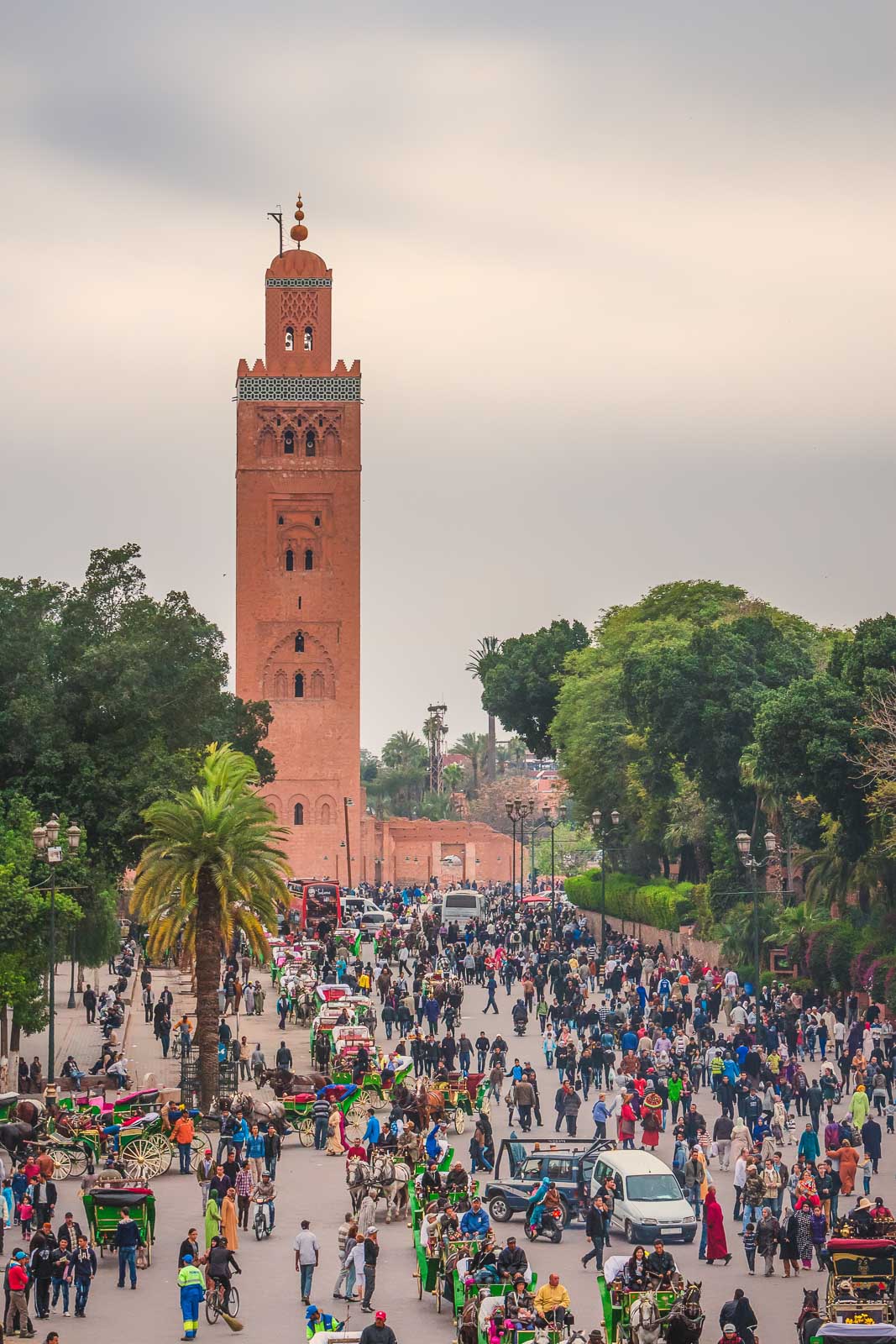
Marrakech, the "Ochre City," is a name that conjures images of bustling souks, fragrant spices, vibrant colours, and the intoxicating allure of North Africa. Nestled at the foot of the majestic Atlas Mountains, this imperial city is a sensory explosion, a captivating blend of ancient traditions and modern energy. From its labyrinthine medina to its serene gardens, Marrakech offers an unforgettable journey for every traveler.
A Tapestry Woven Through Time: The History of Marrakech
Marrakech’s story is as rich and layered as its famous carpets. Founded in the 11th century by Yusuf ibn Tashfin, a leader of the Almoravid dynasty, the city quickly rose to prominence as a major political, economic, and cultural centre. Its strategic location on trade routes connecting the Sahara to the Mediterranean made it a vital hub for merchants and scholars alike.

Related Articles about Marrakech: A Symphony of Senses in the Ochre City:
- Tanzania: A Journey Through Adventure, Wildlife, and Culture
- Ukraine: A Journey Through History, Culture, and Unyielding Spirit
- Brazil: A Symphony of Sun, Samba, and Unforgettable Adventures
- A Tapestry of Wonders: Unveiling the Treasures of Turkey
- Bali: A Traveler’s Paradise – Your Ultimate Guide to the Island of Gods
The Almoravids were followed by the Almohads, who further embellished the city, leaving behind iconic structures like the Koutoubia Mosque. Later, the Saadian dynasty saw a period of renewed prosperity, constructing the stunning Bahia Palace and the Saadian Tombs. Throughout its history, Marrakech has been a seat of power, a melting pot of cultures, and a testament to the enduring spirit of Moroccan artistry and resilience. Its medina, a UNESCO World Heritage site, stands as a living museum, whispering tales of sultans, traders, and everyday life that has unfolded within its ancient walls for centuries.
Unveiling the Treasures: Top Attractions in Marrakech
Marrakech’s magic lies in its ability to surprise and delight at every turn. While the city is vast and diverse, certain landmarks stand out as essential experiences:
-
Jemaa el-Fnaa: The Heartbeat of the City: No visit to Marrakech is complete without immersing yourself in the vibrant chaos of Jemaa el-Fnaa. By day, it’s a sprawling marketplace filled with juice stalls, snake charmers, and storytellers. As dusk descends, the square transforms into a mesmerizing open-air theatre. Food stalls erupt, filling the air with the tantalizing aroma of grilled meats and tagines, while musicians, dancers, and acrobats captivate crowds under the starlit sky. It’s an experience that ignites all your senses.
-
Koutoubia Mosque: The Spiritual Sentinel: Dominating the Marrakech skyline, the Koutoubia Mosque is an architectural masterpiece and a symbol of the city. While non-Muslims cannot enter, its impressive minaret, a fine example of Almohad architecture, is a breathtaking sight, especially when illuminated at night. The surrounding gardens offer a peaceful respite and a perfect vantage point for admiring its grandeur.

-
The Medina and its Souks: A Labyrinth of Wonders: Prepare to get lost, and embrace it! The Marrakech medina is a UNESCO World Heritage site, a labyrinth of narrow alleyways and hidden squares that beckoms exploration. Within its walls lie the legendary souks, a sensory overload of colours, scents, and sounds. From intricately woven carpets and handcrafted leather goods to vibrant ceramics and aromatic spices, the souks offer a treasure trove for shoppers and an unforgettable cultural immersion. Don’t be afraid to haggle; it’s part of the experience!
-
Bahia Palace: A Glimpse into Opulent Living: Built in the late 19th century, the Bahia Palace is a stunning example of Moroccan and Andalusian architecture. Its name means "brilliance," and it certainly lives up to it. Wander through its courtyards adorned with intricate tilework (zellige), carved stucco, and cedarwood ceilings. The private apartments and gardens offer a glimpse into the lavish lifestyle of the vizier who commissioned it.
-
Saadian Tombs: A Hidden Gem: Rediscovered in 1917, the Saadian Tombs are a testament to the grandeur of the Saadian dynasty. These beautifully decorated mausoleums, with their intricate stucco work, mosaics, and carved cedarwood, were once sealed off and forgotten. The Chamber of the Twelve Columns, with its Italian Carrara marble, is particularly awe-inspiring.
-
Jardin Majorelle: An Oasis of Serenity: Escape the hustle and bustle of the medina at the enchanting Jardin Majorelle. This botanical garden, once owned by French painter Jacques Majorelle and later by Yves Saint Laurent, is a vibrant masterpiece of exotic plants, striking blue architecture (Majorelle Blue), and tranquil water features. The Berber Museum within the garden offers a fascinating insight into the rich culture of the indigenous people of North Africa.
-
El Badi Palace: Echoes of Grandeur: Though largely in ruins, El Badi Palace still evokes a sense of its former glory. Once a magnificent palace built by Sultan Ahmad al-Mansur in the late 16th century, it was renowned for its immense size and lavish decorations. Today, the vast courtyards, sunken gardens, and the storks nesting atop its walls offer a hauntingly beautiful spectacle.
-
Ben Youssef Madrasa: An Architectural Marvel: This former Islamic college, dating back to the 16th century, is a breathtaking example of Moorish architecture. Its central courtyard, adorned with intricate stucco, zellige tiles, and carved cedarwood, is a masterpiece of craftsmanship. The surrounding student cells offer a glimpse into the lives of scholars who once studied here.
Navigating Your Moroccan Adventure: Travel Tips for Marrakech
To make the most of your Marrakech experience, consider these practical tips:
-
Currency and Payment: The local currency is the Moroccan Dirham (MAD). While some larger establishments accept credit cards, it’s advisable to carry cash, especially for purchases in the souks and smaller eateries. ATMs are readily available.
-
Language: The official languages are Arabic and Tamazight. French is widely spoken, especially in tourist areas, and English is increasingly understood. Learning a few basic Arabic phrases like "Salam alaykum" (hello) and "Shukran" (thank you) will be appreciated.
-
Dress Code: Morocco is a Muslim country, and while Marrakech is relatively liberal, it’s respectful to dress modestly, especially when visiting religious sites. Aim for clothing that covers your shoulders and knees. Lightweight, breathable fabrics are ideal for the heat.
-
Bargaining: Haggling is an integral part of the shopping experience in the souks. Approach it with a friendly attitude, a smile, and a clear idea of what you’re willing to pay. Start by offering about half of the asking price and negotiate from there.
-
Tipping: Tipping is customary in Morocco. For good service, tip restaurant staff (around 10-15%), taxi drivers (a small amount), and guides.
-
Staying Connected: Wi-Fi is widely available in hotels, riads, and many cafes. Consider purchasing a local SIM card for affordable data if you need to stay connected on the go.
-
Safety: Marrakech is generally a safe city, but like any bustling tourist destination, it’s wise to be aware of your surroundings. Be cautious of pickpockets, especially in crowded areas. Avoid walking alone in dimly lit areas late at night. Be wary of overly persistent street vendors or touts.
-
Hydration: The Moroccan sun can be intense. Drink plenty of bottled water to stay hydrated.
A Haven for Every Traveler: Accommodation Options
Marrakech offers a diverse range of accommodation to suit every budget and style:
-
Riads: The Quintessential Moroccan Experience: For an authentic and intimate stay, choose a riad. These traditional Moroccan houses are built around a central courtyard, often featuring a fountain or small garden. Riads offer a peaceful sanctuary from the bustling medina, with beautifully decorated rooms, attentive service, and delicious homemade breakfasts. They range from budget-friendly to luxurious.
-
Hotels: Marrakech boasts a wide array of hotels, from international chains to boutique properties. You’ll find options both within the medina for an immersive experience and in newer areas like Gueliz and Hivernage for modern amenities and a more relaxed atmosphere.
-
Guesthouses (Dars): Similar to riads, dars are traditional homes offering a more intimate and personalized experience, often at a slightly more affordable price point than larger riads.
-
Hostels: Budget travelers will find a growing number of hostels, particularly in and around the medina, offering a social atmosphere and affordable dormitory or private rooms.
Getting Around the Ochre City: Transportation
Navigating Marrakech is an adventure in itself:
-
Walking: The best way to explore the medina is on foot. Its narrow alleyways are best discovered by wandering, allowing you to stumble upon hidden gems and soak in the atmosphere.
-
Petit Taxis: These small, usually cream-coloured taxis are the most common form of transport for shorter distances within the city. Always agree on a fare before starting your journey, or insist on the meter being used.
-
Grand Taxis: These larger taxis operate on fixed routes and are a more economical option for longer distances or traveling to surrounding areas. They typically depart from designated taxi stations.
-
Horse-Drawn Carriages (Caleshes): For a romantic and leisurely way to see the city, consider a calèche ride. Negotiate the price and route beforehand.
-
Buses: Local buses are available and are a very cheap option, but they can be crowded and routes can be confusing for first-time visitors.
-
Car Rental: While possible, renting a car is generally not recommended for exploring the medina due to its narrow streets and traffic restrictions. It can be useful if you plan to venture out to surrounding areas.
Embracing the Seasons: The Best Time to Visit Marrakech
Marrakech experiences a diverse climate, with hot summers and milder winters. The best time to visit depends on your preferences:
-
Spring (March to May): This is arguably the most pleasant time to visit. The weather is warm and sunny, with average temperatures ranging from 20-25°C (68-77°F). The gardens are in full bloom, and the city buzzes with energy without the intense heat of summer.
-
Autumn (September to November): Similar to spring, autumn offers pleasant temperatures and clear skies. The colours of the medina are vibrant, and the air is crisp, making it ideal for exploring.
-
Winter (December to February): While cooler, winter in Marrakech can still be enjoyable. Daytime temperatures are generally mild (around 15-20°C / 59-68°F), but evenings can be chilly. This is a good time to visit if you prefer fewer crowds and are looking for a more budget-friendly trip. Snow is possible in the Atlas Mountains, offering a dramatic backdrop.
-
Summer (June to August): Summers in Marrakech are very hot, with temperatures often soaring above 35°C (95°F) and sometimes reaching 40°C (104°F) or higher. While the city is still lively, outdoor activities can be challenging during the peak heat of the day. Many visitors opt to stay in air-conditioned accommodations or focus on evening activities.
In conclusion, Marrakech is a city that will capture your heart and ignite your imagination. It’s a place where ancient traditions seamlessly blend with modern life, creating an atmosphere that is both exhilarating and deeply enchanting. Whether you’re haggling for treasures in the souks, sipping mint tea on a rooftop terrace, or simply getting lost in the captivating maze of the medina, Marrakech promises an unforgettable journey for the soul. Pack your sense of adventure and prepare to be swept away by the magic of this extraordinary Ochre City.





